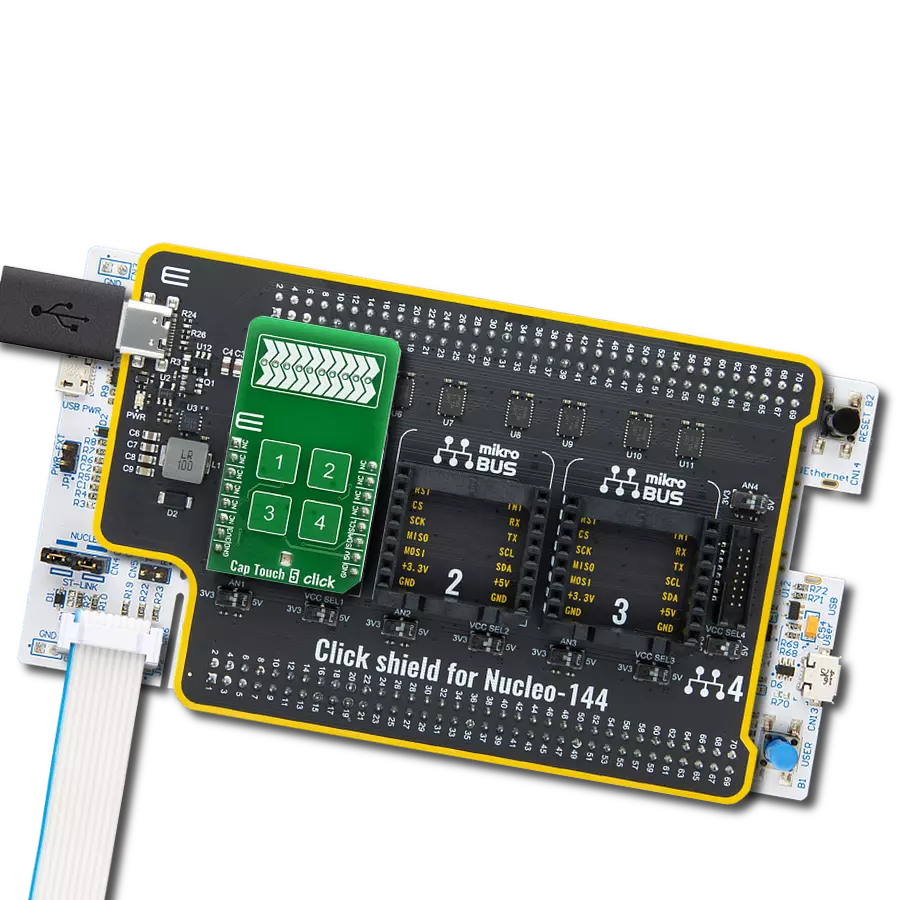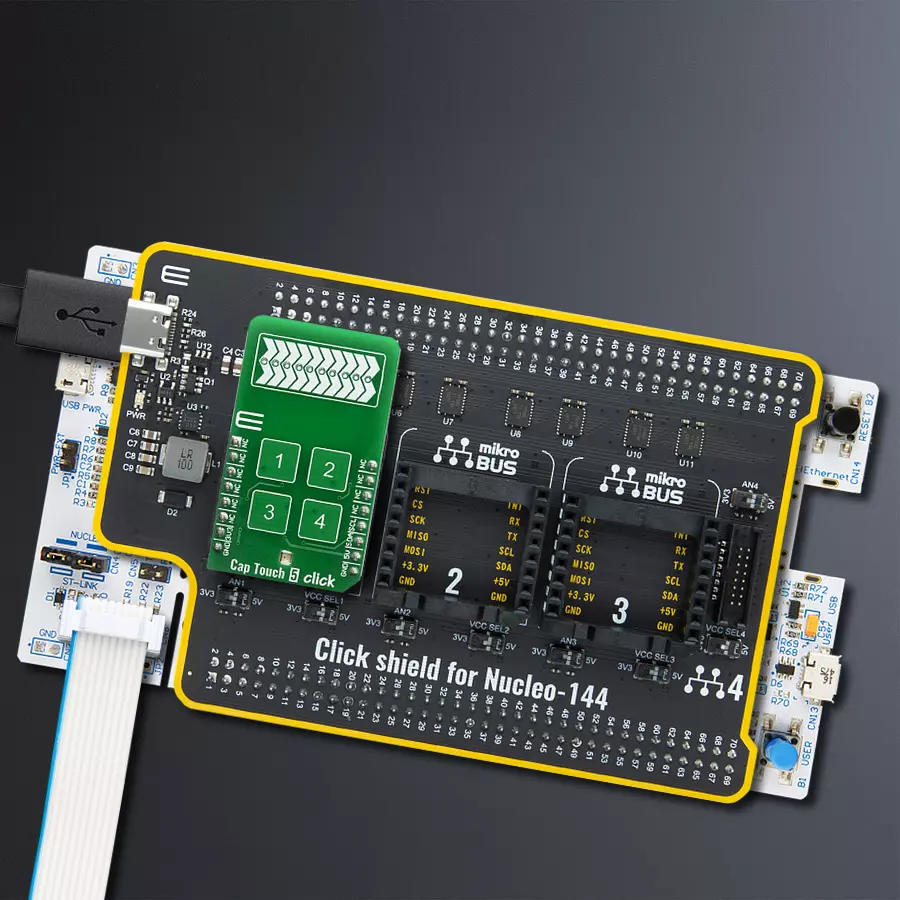Discover a game-changing interface, seamlessly integrating four touch buttons and a slider. Explore its engineering marvel, transforming user interaction across diverse applications
A
A
Hardware Overview
How does it work?
Cap Touch 5 Click is based on the CY8CMBR3106S-LQXI, a CapSense® Express™ controller from Infineon, which has an advanced analog sensing channel and the Capacitive Sigma Delta PLUS (CSD PLUS) sensing algorithm, which delivers a signal-to-noise ratio (SNR) of greater than 100:1 to ensure touch accuracy even in extremely noisy environments. This controller is enabled with Infineon’s SmartSense™ Auto-tuning algorithm, which compensates for manufacturing variations and dynamically monitors and maintains optimal sensor performance in all environmental conditions. In addition, SmartSense Auto-tuning enables a faster time-to-market by eliminating the
time-consuming manual tuning efforts during development and production ramp-up. Advanced features like LED brightness control, proximity sensing, and system diagnostics save development time. These controllers enable robust liquid-tolerant designs by eliminating false touches due to mist, water droplets, or streaming water. The CapSense controller locks up the user interface in firmware to prevent touch inputs in streaming water. Additionally, it implements the advanced noise immunity algorithm, EMC, for stable operation in extremely noisy conditions. Besides that, it is also perfectly suited for low-power applications, such as those operated by a
battery, when a capacitive sensing controller with ultra-low average power consumption must be selected. The CY8CMBR3106S-LQXI controller draws an average current of 22µA per sensor. The Cap Touch 5 Click supports four CapSense buttons. Its sensitivity can be specified individually for each CapSense button and slider. Higher sensitivity values can be used for thick overlays or small button diameters, while lower sensitivity values should be used for large buttons or thin overlays to minimize power consumption. Therefore, this Click board™ comes without the overlay, so it is up to the user to choose the desired application and implementation.
Features overview
Development board
Nucleo-144 with STM32F429ZI MCU board offers an accessible and adaptable avenue for users to explore new ideas and construct prototypes. It allows users to tailor their experience by selecting from a range of performance and power consumption features offered by the STM32 microcontroller. With compatible boards, the
internal or external SMPS dramatically decreases power usage in Run mode. Including the ST Zio connector, expanding ARDUINO Uno V3 connectivity, and ST morpho headers facilitate easy expansion of the Nucleo open development platform. The integrated ST-LINK debugger/programmer enhances convenience by
eliminating the need for a separate probe. Moreover, the board is accompanied by comprehensive free software libraries and examples within the STM32Cube MCU Package, further enhancing its utility and value.
Microcontroller Overview
MCU Card / MCU

Architecture
ARM Cortex-M4
MCU Memory (KB)
2048
Silicon Vendor
STMicroelectronics
Pin count
144
RAM (Bytes)
262144
You complete me!
Accessories
Click Shield for Nucleo-144 comes equipped with four mikroBUS™ sockets, with one in the form of a Shuttle connector, allowing all the Click board™ devices to be interfaced with the STM32 Nucleo-144 board with no effort. This way, MIKROE allows its users to add any functionality from our ever-growing range of Click boards™, such as WiFi, GSM, GPS, Bluetooth, ZigBee, environmental sensors, LEDs, speech recognition, motor control, movement sensors, and many more. Featuring an ARM Cortex-M microcontroller, 144 pins, and Arduino™ compatibility, the STM32 Nucleo-144 board offers limitless possibilities for prototyping and creating diverse applications. These boards are controlled and powered conveniently through a USB connection to program and efficiently debug the Nucleo-144 board out of the box, with an additional USB cable connected to the USB mini port on the board. Simplify your project development with the integrated ST-Link debugger and unleash creativity using the extensive I/O options and expansion capabilities. This Click Shield also has several switches that perform functions such as selecting the logic levels of analog signals on mikroBUS™ sockets and selecting logic voltage levels of the mikroBUS™ sockets themselves. Besides, the user is offered the possibility of using any Click board™ with the help of existing bidirectional level-shifting voltage translators, regardless of whether the Click board™ operates at a 3.3V or 5V logic voltage level. Once you connect the STM32 Nucleo-144 board with our Click Shield for Nucleo-144, you can access hundreds of Click boards™, working with 3.3V or 5V logic voltage levels.
Used MCU Pins
mikroBUS™ mapper
Take a closer look
Click board™ Schematic

Step by step
Project assembly
Track your results in real time
Application Output
1. Application Output - In Debug mode, the 'Application Output' window enables real-time data monitoring, offering direct insight into execution results. Ensure proper data display by configuring the environment correctly using the provided tutorial.

2. UART Terminal - Use the UART Terminal to monitor data transmission via a USB to UART converter, allowing direct communication between the Click board™ and your development system. Configure the baud rate and other serial settings according to your project's requirements to ensure proper functionality. For step-by-step setup instructions, refer to the provided tutorial.

3. Plot Output - The Plot feature offers a powerful way to visualize real-time sensor data, enabling trend analysis, debugging, and comparison of multiple data points. To set it up correctly, follow the provided tutorial, which includes a step-by-step example of using the Plot feature to display Click board™ readings. To use the Plot feature in your code, use the function: plot(*insert_graph_name*, variable_name);. This is a general format, and it is up to the user to replace 'insert_graph_name' with the actual graph name and 'variable_name' with the parameter to be displayed.

Software Support
Library Description
This library contains API for Cap Touch 5 Click driver.
Key functions:
captouch5_read_button_status- This function reads button statuscaptouch5_read_slider_position- This function reads slider position
Open Source
Code example
The complete application code and a ready-to-use project are available through the NECTO Studio Package Manager for direct installation in the NECTO Studio. The application code can also be found on the MIKROE GitHub account.
/*!
* \file
* \brief CapTouch5 Click example
*
* # Description
* This demo app demonstrates basic functionality of CapTouch 5 Click
*
* The demo application is composed of two sections :
*
* ## Application Init
* Initializes I2C module and driver, tests communication and configures device
*
* ## Application Task
* Waiting for touch sensor to detect something and then logs what is touched
*
* *note:*
* Click will go to sleep if doesn't get any command in 340ms
* When you start device try restarting your board few times to start device
*
* \author MikroE Team
*
*/
// ------------------------------------------------------------------- INCLUDES
#include "board.h"
#include "log.h"
#include "captouch5.h"
// ------------------------------------------------------------------ VARIABLES
static captouch5_t captouch5;
static log_t logger;
static T_CAPTOUCH5_BUTTONS buttons;
static T_CAPTOUCH5_DEVICE_CONFIG device_cfg;
static uint8_t state_check;
// ------------------------------------------------------- ADDITIONAL FUNCTIONS
void captouch5_read_buttons( )
{
uint8_t press = 0;
if ( buttons.button1 == CAPTOUCH5_BUTTON_PRESSED )
{
log_info( &logger, "Button 1 : pressed" );
press = 1;
}
if ( buttons.button2 == CAPTOUCH5_BUTTON_PRESSED )
{
log_info( &logger, "Button 2 : pressed" );
press = 1;
}
if ( buttons.button3 == CAPTOUCH5_BUTTON_PRESSED )
{
log_info( &logger, "Button 3 : pressed" );
press = 1;
}
if (buttons.button4 == CAPTOUCH5_BUTTON_PRESSED)
{
log_info( &logger, "Button 4 : pressed" );
press = 1;
}
if (press)
{
log_printf( &logger, "\r\n" );
state_check = 1;
press = 0;
}
}
// ------------------------------------------------------ APPLICATION FUNCTIONS
void application_init ( void )
{
log_cfg_t log_cfg;
captouch5_cfg_t cfg;
/**
* Logger initialization.
* Default baud rate: 115200
* Default log level: LOG_LEVEL_DEBUG
* @note If USB_UART_RX and USB_UART_TX
* are defined as HAL_PIN_NC, you will
* need to define them manually for log to work.
* See @b LOG_MAP_USB_UART macro definition for detailed explanation.
*/
LOG_MAP_USB_UART( log_cfg );
log_init( &logger, &log_cfg );
log_info( &logger, "---- Application Init ----" );
// Click initialization.
captouch5_cfg_setup( &cfg );
CAPTOUCH5_MAP_MIKROBUS( cfg, MIKROBUS_1 );
captouch5_init( &captouch5, &cfg );
captouch5_default_cfg ( &captouch5, &device_cfg );
}
void application_task ( void )
{
uint16_t temp_byte;
uint16_t last_temp;
uint8_t temp_slider;
state_check = 0;
if ( CAPTOUCH5_ERROR == captouch5_process( &captouch5 ) )
{
log_printf( &logger, "***** ERROR *****" );
state_check = 1;
return;
}
temp_byte = captouch5_read_slider_position( &captouch5 );
captouch5_read_button_status( &captouch5, &buttons );
if ( temp_byte != last_temp )
{
log_printf( &logger, "Slider position value: %u \r\n", temp_byte );
last_temp = temp_byte;
state_check = 1;
}
captouch5_read_buttons( );
Delay_ms ( 100 );
if ( state_check == 1 )
{
log_info( &logger, "--- Waiting for command ---\r\n" );
}
}
int main ( void )
{
/* Do not remove this line or clock might not be set correctly. */
#ifdef PREINIT_SUPPORTED
preinit();
#endif
application_init( );
for ( ; ; )
{
application_task( );
}
return 0;
}
// ------------------------------------------------------------------------ END
Additional Support
Resources
Category:Capacitive


































